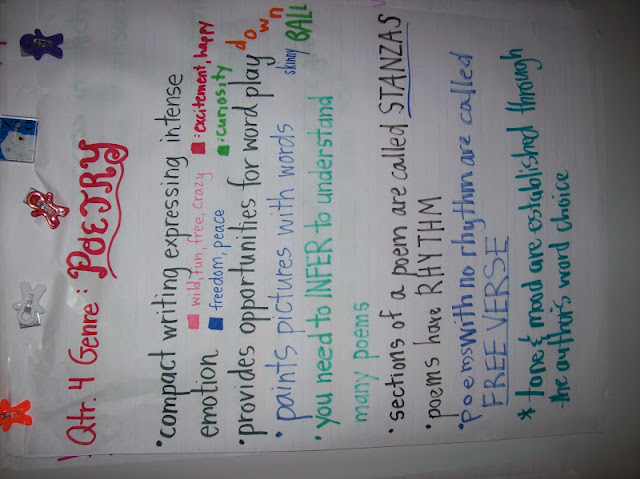To help students discover different tones and moods, I pulled a few pictures from the beginning of the year that showcased a variety of feelings. In the picture below, we brainstormed that Tyson looks like he has happiness inside him while Summer looks a little more disappointed. We listed these two feelings on our tone/mood anchor chart.

Then I showed this picture of Teagan and me doing a reading assessment at the beginning of the year. The class decided that we looked serious, so we added it to our anchor chart as another possible feeling a writer may express or reader may feel.

I also had students analyze a few poems to become aware of the tones and moods felt while reading actual text. After reading this poem about a girl whose mother has died, the class decided that sadness and loneliness were two feelings to add to our anchor chart of tones and moods.
In this poem written by a child whose mom left her evoked feelings of anger and bitterness.
I also brought up the PhotoStory software students used to create their Native American PhotoStories. I said, "Remember when you got to select the music for your PhotoStory projects? Did you notice the word 'mood' above one of the drop-down boxes? You had to decide what mood you wanted your audience to feel so that the music would match it!" We looked at all the words listed and added a few to our chart.
Here is a list of all the feelings we brainstormed as a class from looking at a variety of picture and text samples.
Later in the day, I introduced a mentor text called The Great Migration by Jacob Lawrence. The content overlapped with our social studies curriculum on slaves moving north. As students listened to the text, they were to record powerful phrases and words that truly communicated the tone/mood of hopelessness. This helped students make the connection that it's the specific language we use as writer's that helps to establish the mood for a reader.
Before reading, I explained the difference between the words 'immigrant' and 'migrant' using the following slide.
After reading, I also assessed students' comprehension by asking two questions. The first question is what we call a 'in the text' question, meaning the answer to the question is written and explained in the text. The second question is a 'beyond the text' question, meaning students need to think deeply beyond the literal text to provide their answer.

****
In social studies yesterday, we discussed timelines - how they're organized, how to read them, and how they can help you as a reader of historical or biographical texts. Today students had an assignment to come to class with 5-6 major life events from their own life and the years those events took place. We went to the computer lab, and I modeled how to create a timeline of events using Kidspiration software. After my modeling, students started to construct their own timelines
Once their information was typed into their timelines, I showed students how to navigate the Kidspiration image toolbar to insert a picture to match each event on their timeline. Graphic organizers + technology + social studies curriculum = a happy 4B! The kids love using this program, and I love teaching with it!










I love the way you pulled pictures to show tone/mood. I pinned this to remember!!
ReplyDeleteElizabeth
Fun in Room 4B
I've learned to always tie content to something CONCRETE when introducing it. These kids definitely know pictures of THEMSELVES. :)
Deletehttps://hypersphere.ai cloud comprises an ad hoc dynamic array of cloud portals called 'HyperNodes', downloaded software hosted on global server clouds, local ISPs, and personal devices, representing a heterogeneous hybrid network of its users, i.e. the 'people's network', whereby HyperNode users participate as resource providers to execute transactions, perform computing, and transport data for HyperSphere merchants and service providers.
ReplyDeletehttps://hypersphere.ai/